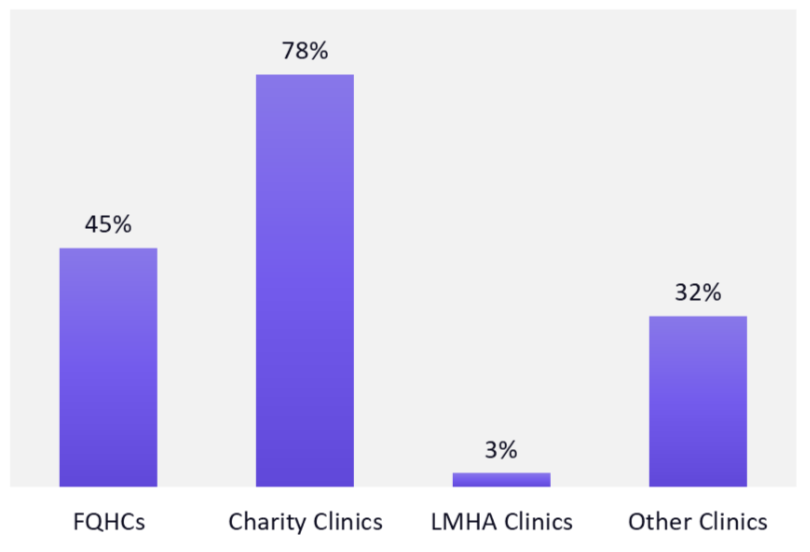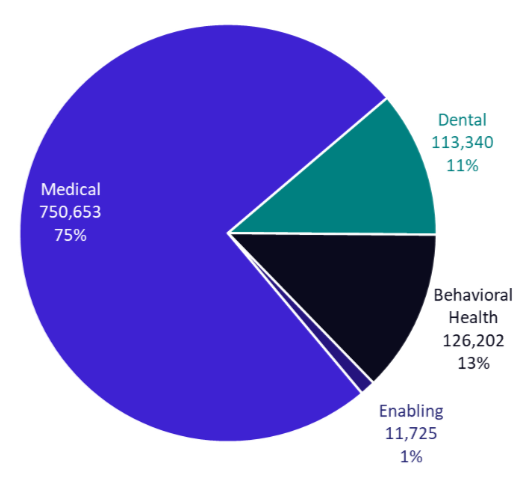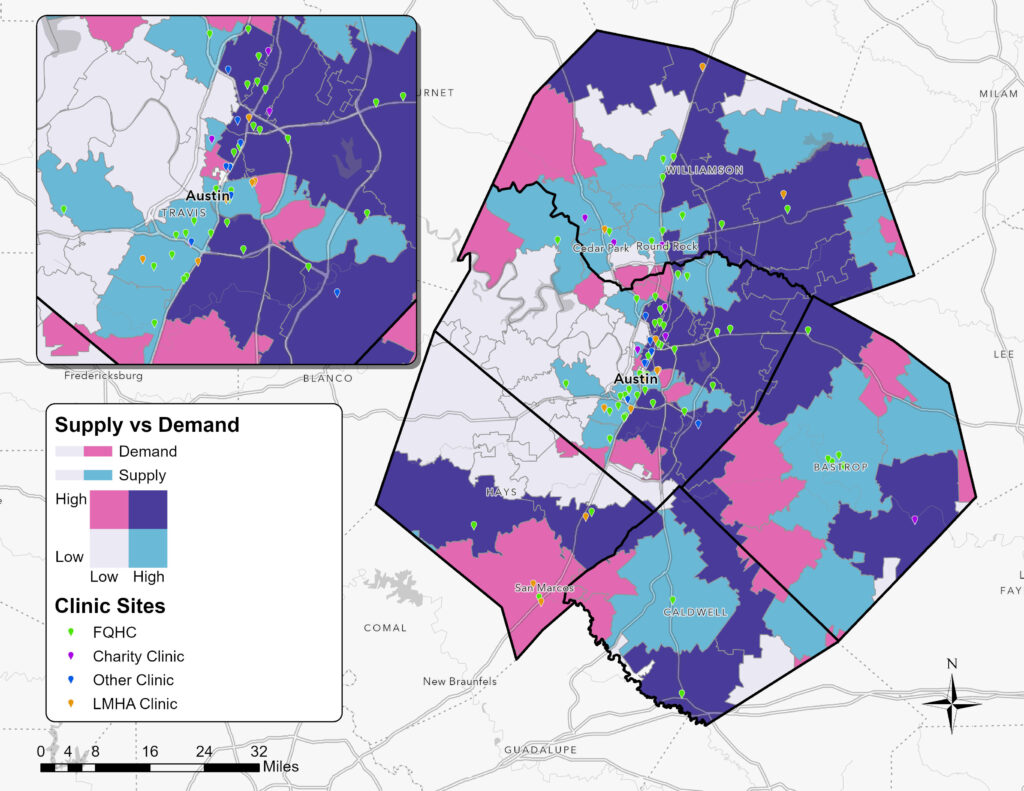Takeaway
Introduction
In 2024, two Texas health foundations, St. David’s Foundation and the Episcopal Health Foundation, funded the Primary Care Capacity Assessment (PCCA), an evaluation to better understand the primary care landscape for uninsured and underinsured residents in the Central Texas region (Bastrop, Caldwell, Hays, Travis, and Williamson Counties). The Primary Care Capacity Assessment provides a data-driven analysis of the primary care safety net, which is defined as organizations and clinicians that deliver essential healthcare services to individuals regardless of their ability to pay (e.g. uninsured or underinsured). Drawing from publicly available data, surveys, interviews, and community input, the assessment provides insight into factors that impact community access to healthcare. The findings will be used to inform decision making about how philanthropy can strategically support access to quality care to advance health equity in Central Texas.
A guiding principle for St. David’s Foundation is to make data-driven decisions aligned with evidence, strategy, and community voice. As we lean into this work, PCCA serves as a critical tool and resource to inform the direction and drive strategic decision making on how the Foundation deploys grantmaking and programmatic resources.
Types of Clinics
There are many types of safety net clinics in Central Texas providing primary care. This study included Federally Qualified Health Centers (FQHCs), Charity Clinics, Local Mental Health Authorities (LMHAs), and “Other Clinics.” (a category in this PCCA that includes four clinics in Central Texas providing specific health services or serving a particular population). Clinic definitions can be viewed here.
The Findings
The assessment evaluated several factors that impact equitable access to primary care, including geographic accessibility, demographics of who is being seen in safety net sites, the type and range of services available, and operational challenges impacting safety net clinics, including financial stability.
Geographical Availability
Most sites that provide primary care to this population are clustered along the I-35 corridor in Austin and Travis County with smaller clusters of sites in Williamson, including in Round Rock, Georgetown, and Cedar Park. While there is a cluster in Bastrop, there are generally fewer primary care sites available in Hays, Caldwell, and Bastrop Counties.
Demand for healthcare services is highest in the Central and Eastern parts of Travis County. Additionally, rural areas outside Travis County also experience significant demand, yet these regions have the fewest nearby providers.
Who is Being Served
FQHCs and Charity Clinics serve Hispanic or Latino patients at almost twice their rate in the Central Texas population, and Charity Clinics serve Asian patients at more than twice their rate in the Central Texas population as well.

Additionally, of all clinic types included, Charity Clinics serve the highest percentage of patients who are best served in a language other than English.

Types of Services Provided and Addressing the Non-Medical Drivers of Health
In this study, medical visits outweigh other types of visits. However, behavioral health and dental health services were also important. Clinics identified that there is a growing need for dental services and behavioral health services throughout the region.

Clinics vary in their ability and capacity to screen and address non-medical drivers of health. However, from those that do screen, food insecurity or access to healthy food was the biggest concern reported by clinics, followed by affordable housing, employment, and financial support.
Financial and Operational Challenges
Clinics in the region have concerns about financial planning for the next five years given uncertainties around revenue sources and escalating costs to provide patient care; however, they anticipate a significant growth in patient volume and demand for their services. Additionally, meeting the demand of this changing population requires clinics to offer extended hours. This is complicated; finding staff to work non-traditional hours and weekends and continuing operations during off hours leads to greater costs.
Sensemaking Session
On October 3, 2024, St. David’s Foundation convened a sensemaking session to ensure the findings reflected the current state of primary care capacity in the region. Representatives from the participating clinic sites relayed that the findings resonated with their lived experience and accurately painted a picture of the primary care safety net in Central Texas. The data sparked a rich discussion across safety net sites that included the following themes:
Transportation Challenges Exacerbate Geographic Accessibility
Even though most clinics in this assessment are strategically positioned to be accessible via public transportation, transportation remains a significant barrier to access care in rural areas. Patients often face challenges with public transit, including long commutes and geographic isolation, resulting in delays and canceled appointments, impacting both the patient and the primary care providers. Community representatives also shared that people will travel far distances if they know they will receive care, especially in their own language.
“People just can’t get there, and they try to make the plans to get there, and they have every intention, they confirm appointments with our team before the appointments. But we are finding that they are still having difficulty getting there. And that’s just a huge problem for us.”- Representative from participating clinic site
Medicaid Disenrollment is Increasing Demand within Safety Net
The demand for services is growing, and thus exceeding available resources, particularly in mental health, dental care, and for specialized populations such as LGBTQ and undocumented individuals and refugees. Furthermore, ongoing issues with the Medicaid redetermination process are adding pressure to the safety net healthcare system, with clinics struggling to serve patients and provide timely access to necessary care.
Dental Care is an Important Safety Net Service
“The single biggest request we get at my clinic is for dental and finding affordable dental care.” – Representative from participating clinic site
Dental services surfaced as a very important issue. The demand for dental care, particularly for adults, is overwhelming due to high costs, limited insurance coverage, and a shortage of providers. Community members shared that dental care is often treated as separate from medical care, but dental health impacts overall health.
Financial Forecast is Impacting Staffing and Hours
“I think we are going to end up with a supply and access issue in the next two years based on the financial constraints we are facing today.” – Representative from participating clinic
Clinics will be facing more financial challenges in the near future. There are, however, other concerns for clinics, such as workforce shortages and compensation pressures. Clinics must address significant challenges in recruiting and retaining staff due to several factors; people have limited availability during the evenings and weekends, and there is pressure to offer higher compensation, particularly in the Austin area.
“…this [assessment] is not reflecting just the work that’s being done and who’s being served, but the gaps in care that we are shooting for in our strategic planning. Please know how much this means to our systems of care as we develop together and strengthen partnerships in place, but also identify those gaps.” – Representative from participating clinic
Conclusion
The primary care safety net in Central Texas faces many challenges as demand increases for primary care, behavioral health, and oral health services. Yet, there is an unwavering desire among clinics to serve those most in need and to continue to provide accessible, quality care to the underinsured and uninsured. This assessment will serve as a baseline to strategically inform our work with the primary care safety net network. Our new strategic plan, Pathways to Health Equity, calls us to address access to care and to define our focus, role, and impact in partnership with community. The Primary Care Capacity Assessment is an important step in that direction.
We want to thank all participating sites and the representatives that participated in the assessment and the sensemaking session. Your voice matters.


